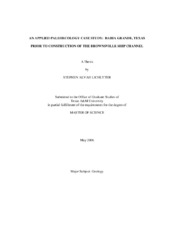| dc.description.abstract | Bahia Grande is a large lagoon located within Laguna Atascosa National Wildlife
Refuge in Cameron County, Texas. When the Brownsville Ship Channel was built along
the southern end of the lagoon in 1936, Bahia Grande was cut off from the marine water
of Laguna Madre. Since that time, Bahia Grande has been primarily dry with only
ephemeral fresh water coming from heavy rainfall events, resulting in a severe decline in
biological productivity. A restoration project led by the U.S. Fish and Wildlife Service
has proposed to cut new channels between Bahia Grande and the Ship Channel to restore
the connection with Laguna Madre. This is a large-scale project with major implications
for the water quality, surrounding ecology, and associated biota in the region.
Unfortunately, because very little is known about Bahia Grande prior to isolation, it is
difficult to predict whether the results of the restoration will be comparable to the pre-Ship Channel environment.
Paleoecological data provide the best opportunity to understand what Bahia
Grande was like in the past. This study uses statistical analyses of the molluscan death
assemblages from Bahia Grande to gain a better understanding of the environmental
conditions in the lagoon before it was isolated. The first question addressed is how does Bahia Grande relate to other water bodies on the Texas coast? This may provide a
modern analog to the past conditions in Bahia Grande. The second question inquires
whether there are any local patterns or variations within Bahia Grande and several
smaller surrounding lagoons. These results provide an important baseline for
comparison with the restored lagoon.
The results of this investigation show that, in a regional context, Bahia Grande
was most similar to Alazan Bay and Baffin Bay, which are mostly enclosed shallow bays
with high salinities due to the arid climate and limited freshwater inflow. Within Bahia
Grande, there are several distinct molluscan assemblages. Salinity and water coverage
are the most likely environmental factors responsible for the differences within Bahia
Grande. Additionally, data from surrounding lagoons strongly indicate that some
connections with Bahia Grande existed in the past. | en |


